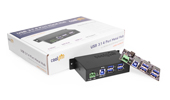Two years ago, smart homes were a novelty gimmick, something that only the very technical and the very silly had installed in their homes. The features were limited, smart devices were barely connected, and the interactions were more fun than useful. But today, smart home hubs and personalities are running the show with more than 120 million active smart speakers in homes and offices across the nation.
Businesses of every stripe are jumping on the band-wagon for voice search, smart-home compatible apps, and custom smart home skills that allow consumers to access their services just by chatting with the friendly smart home personality who lives inside each speaker.
But the real innovations are what smart homes can do for the medical community and the many outpatient health plan members who can benefit from a voice-activated personal assistant. Smart homes have a tremendous amount of potential in the medical industry and we have only just begun to realize that potential. Join us today as we dive into five different ways that smart homes can be used to enhance the quality of care and plan engagement for your patients.
1) Smart Home Reminders on the Plan Schedule
The easiest and accessible way to use a smart home for medical purposes is the simple friendly reminder feature. Smart homes have a friendly, cheerful voice that never forgets an appointment or a scheduled medication. Once programmed to give daily reminders, a smart home will provide those reminders to patients in their home unfailingly. As long as the internet is active.
In fact, some smart homes can even forward these reminders to the phones of patients if they happen to be out of the house when that scheduled reminder comes around.
2) Calls and Voice Communication with Healthcare Providers
As the population moves away from phone calls, you would think that voice communication would be a short-lived trend, but you’d be wrong. There is a delightful novelty to speaking into the air and holding an ongoing phone conversation, and doctors are already benefitting from this when helping patients who don’t come in for checkups.
Through smart home phone and voice communication features, patients can call their healthcare providers without picking up the phone and doctors can ‘drop-in’ without needing to schedule a call or ask patients to have their phones on hand.
As you can imagine, this feature is even more important in the common medical situations when patients at home can’t reach the phone but may need a consultation, check-in, or to request emergency help all the same.
3) Voice-Searchable Health Plan Information
Voice search is when a smart home user asks their friendly home AI a question, and the AI pulls up the most convenient and seemingly relevant answer from the internet to recite back to them. Voice search is becoming increasingly popular as homeowners and patients discover that they can learn through conversation with their smart homes instead of having to comb through internet research and reading themselves.
Healthcare plan providers can take advantage of this new easy way to get information by making sure their patient help center answers and personal medical plan information is available to patients who are asking their smart home for answers when they should be asking a physician. This can be done by voice-search optimizing your web pages and by building a unique smart home skill designed to provide health plan answers in response to certain keywords in each spoken question.
4) Smart Devices That Coordinate the Health Plan
Smart devices, also known as devices on the Internet of Things (IoT) or wireless mobile-controllable devices have been becoming ever more prominent in the medical industry. From wearable devices to implanted devices to home medical machines, smart homes make it possible for both patients and healthcare providers to remotely communicate with these devices in order to improve a patient’s at-home health experience.
5) Interactive Smart Home Health Plan Skill
Finally, there are smart home skills. Skills are unique programs designed to expand the capabilities of a smart home AI to encompass more features, answers, and functions than the base program allows for. A commercial example includes the ability to order a pizza or control a new smart blender added to the home IoT collection. But in the medical field, custom smart home skills could be used to truly reach the patient-assisting potential of smart home technology.
It all depends on what your health plan organization can put together to provide new services and usable home features to health plan members with smart homes installed.
—
Want to learn more about improving your patient health with cutting-edge technology? Contact us today!



















